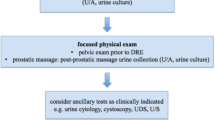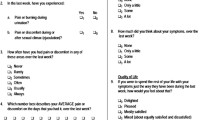Abstract
Introduction
The development of an accepted clinical definition, classification system and validated outcome questionnaire for chronic prostatitis/chronic pelvic pain syndrome (CP/CPPS) has led to a flurry of clinical trial activity over the last 15 years.
Methods
Twenty-four of these studies enrolled a homogeneous population of CP/CPPS patients, were prospective randomized placebo or sham controlled, and employed the National Institutes of Health chronic prostatitis symptom index (CPSI) as an outcome parameter.
Results
This review of the evidence and clinical impact from these studies suggests that physician’s strict adherence to a rigid evidence-based approach for the treatment of a CP/CPPS patient will result in disappointed patients as well as disappointed physicians.
Conclusions
There is no one particular treatment that shows significant clinical efficacy to be recommended as a mono-therapy for CP/CPPS. Therefore, the physician must adapt his knowledge and interpretation of the evidence from randomized placebo- and sham-controlled trials to determine what therapy or therapies are best indicated for each individual patient.
Similar content being viewed by others
References
Krieger JN, Nyberg L, Nickel JC (1999) NIH consensus definition and classification of prostatitis. JAMA 282:236–237
Schaeffer AJ (2008) Chronic prostatiitis and chronic pelvic pain syndrome. NEJM 355:1690–1698
Litwin MS, McNaughton-Collins M, Fowler FJ Jr, Nickel JC, Calhoun EA, Pontari MA, Alexander RB, Farrar JT, O’Leary MP (1999) The National Institutes of Health chronic prostatitis symptom index: development and validation of a new outcome measure. Chronic Prostatitis Collaborative Research Network. J Urol. 162:369–375
Propert KJ, Wang Y, Alexander R, Calhoun EA, Nickel JC, O’Leary M, Pontari M, Litwin M, McNaughton-Collins M, the Chronic Prostatitis Collaborative Research Network (CPCRN) (2006) Responsiveness of the NIH-CPSI. QOL Res 15(2):299–305
Zhou Z, Hong L, Shen X et al (2008) Detection of nanobacteria infection in type III prostatitis. Urology 71:1091
Nickel JC, Downey J, Clark J et al (2003) Levofloxacin for chronic prostatitis/chronic pelvic pain syndrome in men: a randomized placebo-controlled multicenter trial. Urology 62:614–617
Alexander RB, Propert KJ, Schaeffer AJ et al (2004) Ciprofloxacin or tamsulosin in men with chronic prostatitis/chronic pelvic pain syndrome: a randomized, double-blind trial. Ann Intern Med 141:581–589
Nickel JC, Downey J, Johnston B, Clark J, the Canadian Prostatitis Research Group (2001) Predictors of response to antibiotic therapy for chronic prostatitis/chronic pelvic pain syndrome: a prospective multicenter clinical study. J Urol 165:1539–1544
Nickel JC, Xiang J (2008) Clinical significance of non-traditional uropathogens in the management of chronic prostatitis. J Urol 179:1391–1395
Anothaisintawee T, Attia J, Nickel JC et al (2011) Management of chronic prostatitis/chronic pelvic pain syndrome: a systematic review and network meta-analysis. JAMA 305:78–86
Thakkinstian A, Attia J, Anothaisintawee T, Nickel JC (2012) Alpha-blockers, antibiotics and anti-inflammatories have a role in the management of chronic prostatitis/chronic pelvic pain syndrome (CP/CPPS). BJUI. 110:1014–1022
Ogino H, Fujii M, Ono M, Maezawa K, Hori S, Kizu J (2009) In vivo and in vitro effects of fluoroquinolones on lipopolysaccharide-induced pro-inflammatory cytokine production. J Infect Chemother 15:168–173
Tsivkovskii R, Sabet M, Tarazi Z, Griffith DC, Lomovskaya O, Dudley MN (2011) Levofloxacin reduces inflammatory cytokine levels in human bronchial epithelia cells: implications for aerosol MP-376 (levofloxacin solution for inhalation) treatment of chronic pulmonary infections. FEMS Immunol Med Microbiol 61:141–146
Cheah PY, Liong ML, Yuen KH et al (2003) Terazosin therapy for chronic prostatitis/chronic pelvic pain syndrome: a randomized, placebo controlled trial. J Urol 169:592–596
Chen Y, Wu X, Liu J, Tang W, Zhao T, Zhang J (2011) Effects of a 6-month course of tamsulosin for chronic prostatitis/chronic pelvic pain syndrome: a multicenter, randomized trial. World J Urol 29:381–385
Nickel JC, Narayan P, McKay J, Doyle C (2004) Treatment of chronic prostatitis/chronic pelvic pain syndrome with tamsulosin: a randomized double blind trial. J Urol 171:1594–1597
Mehik A, Alas P, Nickel JC, Sarpola A, Helstrom PJ (2003) Alfuzosin treatment for chronic prostatitis/chronic pelvic pain syndrome: a prospective, randomized, double-blind, placebo-controlled, pilot study. Urology 62:425–429
Nickel JC, Krieger JN, McNaughton-Collins M et al (2008) Alfuzosin and symptoms of chronic prostatitis-chronic pelvic pain syndrome. N Engl J Med 2008(359):2663–2673
Tugcu V, Tasci AI, Fazlioglu A et al (2007) A placebo-controlled comparison of the efficiency of triple- and monotherapy in category III B chronic pelvic pain syndrome (CPPS). Eur Urol 51:1113
Nickel JC, O’Leary MP, Lepor H et al (2011) Silodosin for men with chronic prostatitis/chronic pelvic pain syndrome: results of a Phase II multicenter, double-blind, placebo-controlled study. J Urol 186:125–131
Yang G, Wei Q, Li H, Yang Y, Zhang S, Dong Q (2006) The effect of alpha-adrenergic antagonists in chronic prostatitis/chronic pelvic pain syndrome: a meta-analysis of randomized controlled trials. J Androl 27(6):847–852
Nickel JC, Pontari M, Moon T et al (2003) A randomized, placebo controlled, multicenter study to evaluate the safety and efficacy of rofecoxib in the treatment of chronic nonbacterial prostatitis. J Urol 169:1401–1405
Zhao WP, Zhang ZG, Li XD et al (2009) Celecoxib reduces symptoms in men with difficult chronic pelvic pain syndrome (Category IIIA). Braz J Med Biol Res 42:963–967
Nickel JC, Forrest JB, Tomera K et al (2005) Pentosan polysulfate sodium therapy for men with chronic pelvic pain syndrome: a multicenter, randomized, placebo controlled study. J Urol 173:1252–1255
Goldmeier D, Madden P, McKenna M, Tamm N (2005) Treatment of category III A prostatitis with zafirlukast: a randomized controlled feasibility study. Int J STD AIDS 16:196–200
Bates SM, Hill VA, Anderson JB et al (2007) A prospective, randomized, double-blind trial to evaluate the role of a short reducing course of oral corticosteroid therapy in the treatment of chronic prostatitis/chronic pelvic pain syndrome. BJU Int 99:355–359
Shoskes DA, Zeitlin SI, Shahed A, Rajfer J (1999) Quercetin in men with category III chronic prostatitis: a preliminary prospective, double-blind, placebo-controlled trial. Urology 54:960–963
Wagenlehner FM, Schneider H, Ludwig M, Schnitker J, Brahler E, Weidner W (2009) A pollen extract (Cernilton) in patients with inflammatory chronic prostatitis-chronic pelvic pain syndrome: a multicentre, randomised, prospective, double-blind, placebo-controlled phase 3 study. Eur Urol 56:544–551
Pontari MA, Krieger JN, Litwin MS et al (2010) Pregabalin for the treatment of men with chronic prostatitis/chronic pelvic pain syndrome: a randomized controlled trial. Arch Intern Med 170:1586–1593
Nickel JC, Downey J, Pontari MA, Shoskes DA, Zeitlin SI (2004) A randomized placebo-controlled multicentre study to evaluate the safety and efficacy of finasteride for male chronic pelvic pain syndrome (category IIIA chronic nonbacterial prostatitis). BJU Int 93:991–995
De Rose AF, Gallo F, Giglio M, Carmignani G (2004) Role of mepartricin in category III chronic nonbacterial prostatitis/chronic pelvic pain syndrome: a randomized prospective placebo-controlled trial. Urology 63:13–16
Nickel JC, Roehrborn C, Montorsi F, Wilson TH, Rittmaster RS (2011) Dutasteride reduces prostatitis symptoms compared with placebo in men enrolled in the REDUCE study. J Urol 186:1313–1318
FitzGerald MP, Anderson RU, Potts J et al (2009) Randomized multicenter feasibility trial of myofascial physical therapy for the treatment of urological chronic pelvic pain syndromes. J Urol 182:570–580
Zimmermann R, Cumpanas A, Miclea F et al (2009) Extracorporeal shock wave therapy for the treatment of chronic pelvic pain syndrome in males: a randomized, double-blind, placebo-controlled study. Eur Urol 56:418
Kabay S, Kabay SC, Yucel M, Ozden H (2009) Efficiency of posterior tibial nerve stimulation in category IIIB chronic prostatitis/chronic pelvic pain: a Sham-Controlled Comparative Study. Urol Int 83:33–38
Rowe E, Smith C, Laverick L, Elkabir J, Witherow RO, Patel A (2005) A prospective, randomized, placebo controlled, double-blind study of pelvic electromagnetic therapy for the treatment of chronic pelvic pain syndrome with 1 year of followup. J Urol 173:2044–2047
Lee SW, Liong ML, Yuen KH et al (2008) Acupuncture versus sham acupuncture for chronic prostatitis/chronic pelvic pain. Am J Med 121:79.e1–79.e7
Lee SH, Lee BC (2009) Electroacupuncture relieves pain in men with chronic prostatitis/chronic pelvic pain syndrome: three-arm randomized trial. Urology 73:1036–1041
Anderson RU, Wise D, Sawyer T, Glowe P, Orenberg EK (2011) 6-day intensive treatment protocol for refractory chronic prostatitis/chronic pelvic pain syndrome using myofascial release and paradoxical relaxation training. J Urol 185:1294–1299
Leskinen MJ, Kilponen A, Lukkarinen O, Tammela TL (2002) Transurethral needle ablation for the treatment of chronic pelvic pain syndrome (category III prostatitis): a randomized, sham-controlled study. Urology 60:300–304
Nickel JC, Mullins C, Tripp DA (2008) Development of an evidence-based cognitive behavioral treatment program for men with chronic prostatitis/chronic pelvic pain syndrome. World J Urol 26:167–172
Nickel JC, Downey J, Ardern D, Clark J, Nickel K (2004) Failure of monotherapy strategy for the treatment of difficult chronic prostatitis/chronic pelvic pain syndrome patients. J Urol 172:551–554
Shoskes DA, Hakim L, Ghoniem G, Jackson CL (2003) Long-term results of multimodal therapy for chronic prostatitis/chronic pelvic pain syndrome. J Urol 169:1406–1410
Shoskes DA, Nickel JC, Dolinga R, Prots D (2009) Clinical phenotyping of patients with chronic prostatitis/chronic pelvic pain syndrome and correlation with symptom severity. Urology 73:538–542; discussion 542–3
Nickel JC, Shoskes D (2010) Phenotypic approach to the management of the chronic prostatitis/chronic pelvic pain syndrome. BJU Int 106:1252–1263
Shoskes DA, Nickel JC, Kattan MW (2010) Phenotypically directed multimodal therapy for chronic prostatitis/chronic pelvic pain syndrome: a prospective study using UPOINT. Urology 75:1249–1253
Shoskes DA, Nickel JC (2013) Classification and Treatment of Men with Chronic Prostatitis/Chronic Pelvic Pain Syndrome Using the UPOINT System. World J Urol. doi:10.1007/s00345-013-1075-6
Nickel C, Atkinson G, Krieger J, Mills J, Pontari M, Shoskes D, Crook T (2012) Preliminary assessment of safety and efficacy in a proof-of-concept, randomized clinical trial of tanezumab for chronic prostatitis/chronic pelvic pain syndrome (CP/CPPS). Urology 80:1105–1110
Author information
Authors and Affiliations
Corresponding author
Rights and permissions
About this article
Cite this article
Nickel, J.C., Shoskes, D.A. & Wagenlehner, F.M.E. Management of chronic prostatitis/chronic pelvic pain syndrome (CP/CPPS): the studies, the evidence, and the impact. World J Urol 31, 747–753 (2013). https://doi.org/10.1007/s00345-013-1062-y
Received:
Accepted:
Published:
Issue Date:
DOI: https://doi.org/10.1007/s00345-013-1062-y




